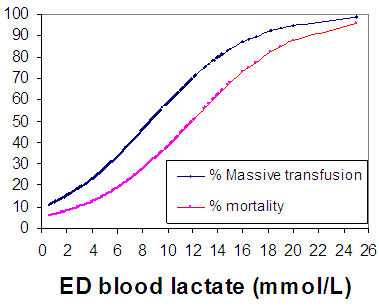|
Back to Annual Meeting Program
Lactate Predicts the Need for Massive Transfusion in Severe Blunt Trauma: an Analysis of the Glue Grant Database
*Antonios C Sideris, *George Kasotakis, *Ali Y Mejaddam, *Yuchiao Chang, *Marc A de Moya, *Peter J Fagenholz, Ronald G Tompkins, George C Velmahos
Massachusetts General Hospital, Boston, MA
Objective:
The purpose of our study was to examine if emergency department (ED) blood lactate (BL) levels can predict need for massive transfusion (MT) and in-hospital mortality after severe blunt trauma.
Design:
Secondary analysis of a prospective, federally funded database
Setting:
19 academic and non-academic trauma centers
Patients:
1719 adult patients that sustained blunt non-brain trauma with hypotension in the field or within 1 hour of ED arrival and necessitated ≥1 packed red blood cells (PRBC) units in the first 12 hours.
Main Outcome Measures:
Massive transfusion (MT, ≥10 PRBC units in 24 hours) and in-hospital mortality.
Results:
1719 patients were included (age 44 ± 18, 67% male, median ISS 34, median GCS 6). Median ED BL was 4mmol/L. MT was required in 27% of patients, with a median of 6 PRBC units per patient. In-hospital mortality was 16%. Results of multivariable logistic regression models are seen below. The ED BL was more predictive than ED SBP for MT (area under curve (AUC) 0.70 vs. 0.59, p<0.001) and in-hospital mortality (AUC 0.70 vs. 0.57, p<0.001).
Conclusions:
ED BL independently predicts the need for massive transfusion and in-hospital mortality in severe blunt trauma patients. Point-of-care BL devices will help health-care providers understand the severity of disease and make decisions about triggering MT protocols.
 
Back to Annual Meeting Program
|
|
